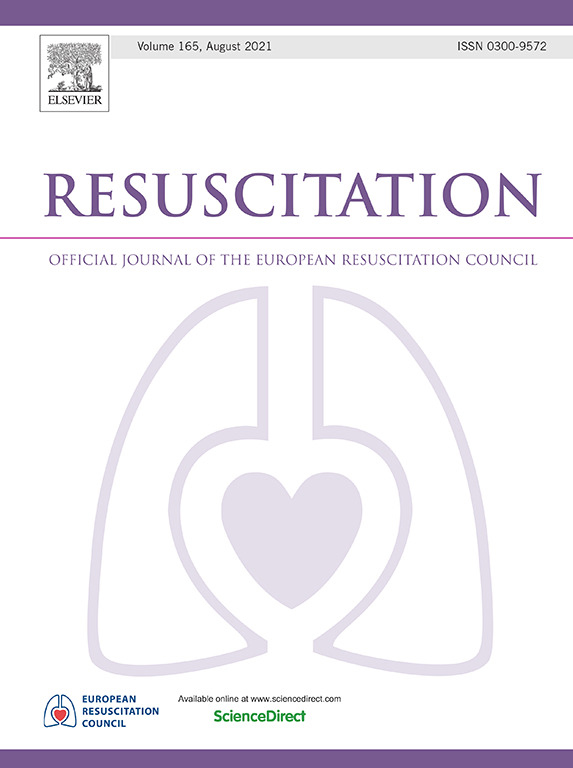Optimizing extracorporeal cardiopulmonary resuscitation delivery for out-of-hospital cardiac arrest: a Monte Carlo simulation study
IF 4.6
1区 医学
Q1 CRITICAL CARE MEDICINE
引用次数: 0
Abstract
Background
Extracorporeal cardiopulmonary resuscitation (ECPR) can improve outcomes in refractory out-of-hospital cardiac arrest (OHCA), but access is limited by geographic and system constraints. We aimed to compare the potential impact of different ECPR delivery strategies in an urban setting using simulation modeling.
Methods
We performed a Monte Carlo simulation using historical OHCA data (2015–2019) from Montreal’s sole EMS. Each of 2000 iterations simulated 1240 annual OHCA cases using geospatial heatmaps. Patients meeting ECPR criteria (witnessed arrest, bystander CPR, age ≤ 70 years old) were included. We tested in-hospital models (2-, 3-, and 4-hospital), a rendezvous model, and two prehospital strategies: hospital-based deployment and an optimally located mobile team. Transport times were estimated using a machine learning model trained on real operational data. Outcomes included survival with favorable neurological outcome, proportion of patients achieving flow recovery at 60 min and low-flow time.
Results
On average, 255 patients were included per iteration. With in-hospital ECPR delivery, increasing from 2 to 4 hospitals modestly improved CPC 1–2 survival (25.3% vs 28.0%), flow recovery at 60 min (69.2% vs 75.1%), and low-flow interval (-2.4 min. Rendezvous yielded 28.8% CPC 1–2 survival, 77.3% flow-recovery at 60 min and -2.9 min low-flow time. Prehospital strategies had the greatest impact, improving CPC 1–2 survival (39.5% and 42.0%), flow-recovery at 60 min (99.7% and 100%), and low-flow time (-7.8 and -12 min) for hospital-based and optimally placed teams respectively.
Conclusion
In this simulation, prehospital ECPR strategies showed the potential to increase survival, improve flow recovery at 60 min, and reduce low-flow times in urban OHCA.
院外心脏骤停的体外心肺复苏优化:蒙特卡洛模拟研究。
背景:体外心肺复苏(ECPR)可以改善难治性院外心脏骤停(OHCA)的预后,但由于地理和系统的限制,其使用受到限制。我们的目的是通过模拟建模来比较不同ECPR交付策略在城市环境中的潜在影响。方法:我们使用蒙特利尔唯一EMS的历史OHCA数据(2015-2019)进行蒙特卡罗模拟。2000次迭代中的每一次都使用地理空间热图模拟1240例年度OHCA病例。符合ECPR标准的患者(目击骤停、旁观者CPR、年龄≤70岁)纳入研究。我们测试了院内模型(2、3和4家医院)、集合模型和两种院前策略:基于医院的部署和最佳位置的移动团队。运输时间的估计使用了经过实际操作数据训练的机器学习模型。结果包括神经系统预后良好的生存期,在60分钟和低流量时间内实现血流恢复的患者比例。结果:平均每次迭代纳入255例患者。对于院内ECPR分娩,从2家医院增加到4家医院,略微提高了CPC 1-2生存率(25.3%对28.0%)、60分钟血流恢复(69.2%对75.1%)和低流量间隔(-2.4分钟)。Rendezvous的CPC 1-2存活率为28.8%,60分钟时的流量回收率为77.3%,低流量时间为-2.9分钟。院前策略的影响最大,分别提高了医院和最佳安置团队的CPC 1-2生存率(39.5%和42.0%)、60分钟流量恢复(99.7%和100%)和低流量时间(-7.8分钟和-12分钟)。结论:在本模拟中,院前ECPR策略显示出在城市OHCA中提高生存率、改善60分钟流量恢复并减少低流量时间的潜力。
本文章由计算机程序翻译,如有差异,请以英文原文为准。
求助全文
约1分钟内获得全文
求助全文
来源期刊

Resuscitation
医学-急救医学
CiteScore
12.00
自引率
18.50%
发文量
556
审稿时长
21 days
期刊介绍:
Resuscitation is a monthly international and interdisciplinary medical journal. The papers published deal with the aetiology, pathophysiology and prevention of cardiac arrest, resuscitation training, clinical resuscitation, and experimental resuscitation research, although papers relating to animal studies will be published only if they are of exceptional interest and related directly to clinical cardiopulmonary resuscitation. Papers relating to trauma are published occasionally but the majority of these concern traumatic cardiac arrest.
 求助内容:
求助内容: 应助结果提醒方式:
应助结果提醒方式:


